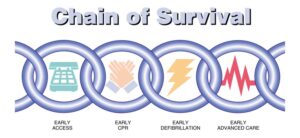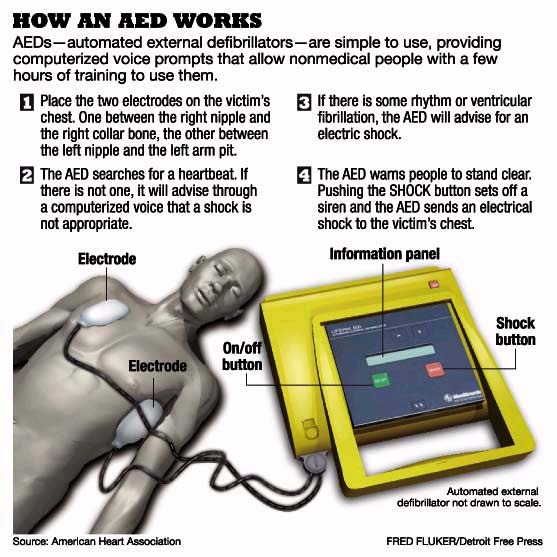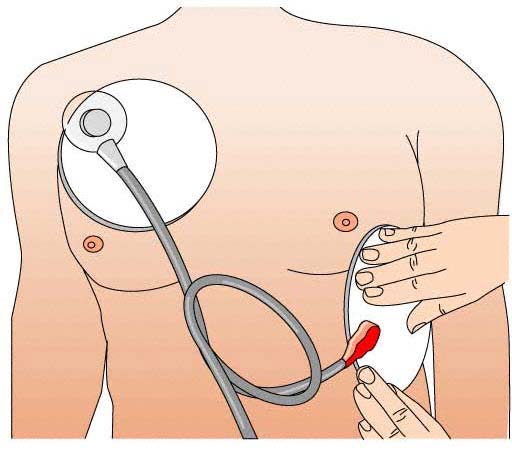LESSON 8 Administer CPR and Automated External Defibrillation (AED) on an Unconscious Casualty with Suspected Cardiac Arrest.
TEXT ASSIGNMENT Paragraphs 8-1 to 8-5.
LESSON OBJECTIVES After completing this lesson, you should be able to:
8-1. Identify the proper indications for early defibrillation.
8-2. Identify the proper procedures for integrating the AED and CPR.
8-3. Identify the proper procedures for caring for a patient after the AED delivers its shock.
8-4. Identify the proper procedures for cardiac arrest during patient transport.
8-5 Identify the proper procedures for maintaining an AED.
SUGGESTION After you have completed the text assignment, work the exercises at the end of this lesson before beginning the next lesson. These exercises will help you to achieve the lesson objectives.
Overview
8-1. INDICATIONS FOR EARLY DEFIBRILLATION
Very few patients who experience sudden cardiac arrest outside of a hospital survive unless a rapid sequence of events takes place. The chain of survival (figure 8-1) is a way of describing the ideal sequence of events that can take place when such an arrest occurs.

a. Recognition of early warning signs and immediate activation of emergency medical support. Few patients benefit from defibrillation when more than 10 minutes elapse before administration of the first shock and/or CPR is not performed in the first 2 to 3 minutes.
b. Immediate bystander CPR. Cardiopulmonary resuscitation helps prolong the time during which defibrillation can be effective.
c. Early defibrillation. This may be the most important link in the chain of survival. Rapid defibrillation has successfully resuscitated many patients with cardiac arrest from ventricular fibrillation. Figure 8-2 shows how an automated external defibrillator (AED) works.
d. Early advanced cardiac life support.

8-2. PROCEDURES FOR INTEGRATING THE AUTOMATED EXTERNAL DEFIBRILLATOR AND CARDIOPULMONARY RESUSCITATION
It is important to know how to integrate the AED into the CPR sequence. If an AED is immediately available, it should be attached to the patient and treatment should be initiated. Delaying CPR at this point is justified because the defibrillation sequence will be started right away. If the AED is not immediately available or if CPR is already in progress, follow these steps.
a. Arrive on the scene and perform your initial assessment. Assess the patient for responsiveness. If the patient is responsive, do not apply the AED. A conscious patient may be in ventricular tachycardia, which is recognized as a shockable rhythm by the AED. It is not advised to shock a conscious patient with the AED.
b. Stop CPR.
c. Verify pulselessness and apnea. Check for “adequate” breathing and a pulse.
d. Resume CPR.
e. Prepare the AED.
f. Turn on the machine.
g. Remove the clothing from the patient’s chest area and apply AED pads.
(1) Apply the two pads to the patients’ bare chest (figure 8-3). Apply one pad to the right of the sternum just below the clavicle. Apply the other pad to the left part of the chest with the top of the pad 2 to 3 inches below the armpit.

(2) Ensure the pads are attached to the patient cables and that the cables are attached to the AED.
(3) Do not apply the AED pads over transdermal medication patches, implanted defibrillators, or pacemakers.
(4) For a patient with excessive chest hair, shave the areas under the pads before application.
h. Stop CPR.
NOTE: The AED will usually provide prompts for the proper sequence.
i. State aloud, “Clear the patient.”
(1) Once this is stated, look around the patient and make sure that no rescuer is still in contact with the patient.
(2) Look to ensure that the patient is not in contact with water or any other source of conduction that may cause you to be electrocuted by the defibrillator.
j. Push the analyze button.
NOTE: Do not touch or ventilate the patient during the analyze sequence.
k. If advised to do so, push the shock button.
NOTE: Before pushing the shock button, clear the patient again by verbalizing, “Clear the patient,” and visually verify that all rescuers and equipment are away from the patient.
l. After the shock is delivered, begin CPR.
(1) Begin chest compressions at a cycle of 30:2.
(2) Conduct 5 cycles of 30:2 (about 2 minutes of CPR) and then assess for adequate pulse.
(3) If an adequate pulse is detected, monitor the patient as described in paragraph 8-3. If an adequate pulse is not detected, repeat the defibrillation sequence.
m. Repeat the defibrillation sequence, if needed. Repeat the sequence of analyzing, shocking, and five cycles of CPR until on of the following occurs:
(1) Six shocks have been delivered.
(2) A “no shock advised” is issued by the AED
(3) The patient has a return of adequate spontaneous pulse.
n. Prepare the patient for immediate transport if.
(1) The patient has return of adequate pulse.
(2) Six sets of shocks have been delivered.
(3) The AED advises “no shock advised” and the patient is still pulseless.
8-3. CARING FOR A PATIENT AFTER THE AED DELIVERS ITS SHOCK
a. If the patient has regained a pulse:
(1) Assess for adequate breathing and treat appropriately with assisted ventilations with supplemental oxygen or with just supplemental oxygen.
(2) Prepare the patient for transport.
(3) Monitor the patients pulse every 30 seconds in case the patient returns to a pulseless state and CPR is needed.
b. If the patient does not have a pulse and the AED indicates that no shock is advised:
(1) Continue CPR at 30:2 for five cycles (about two minutes) and then reassess the pulse.
(2) Prepare the patient for transport.
c. If the patient does not have a pulse and the AED indicates that a shock is advised.
(1) Clear the patient.
(2) Press the push to shock button to deliver the shock.
(3) Resume CPR at 30:2 for five cycles and then reassess the pulse.
8-4. CARDIAC ARREST DURING PATIENT TRANSPORT
a. Stop the vehicle.
b. If the AED is not immediately available, perform CPR until it is.
c. Analyze the rhythm.
d. Deliver shock if indicated.
e. Continue resuscitation.
8-5. MAINTAINING AN AUTOMATED EXTERNAL DEFIBRILLATOR
a. Read the operator’s manual.
b. Get a checklist from the manufacturer.
c. Check the AED and battery at the beginning of each day.
d. Report any failures to the manufacturer and the Food and Drug Administration (FDA).
